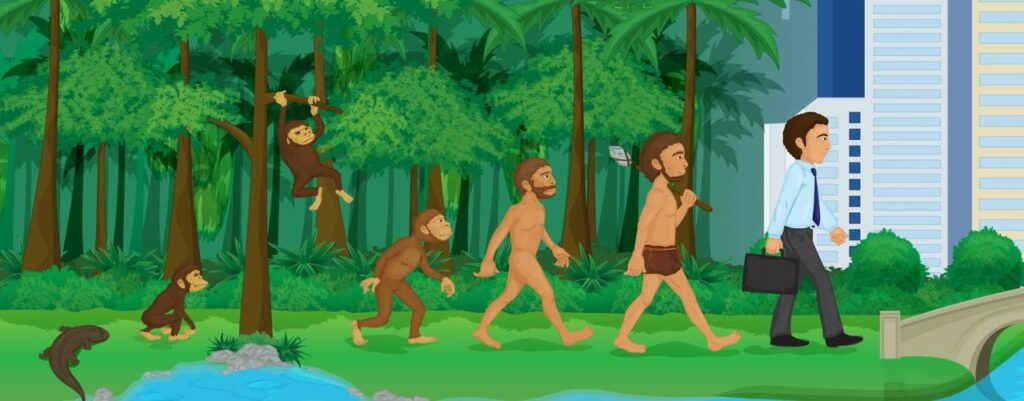Industry 4.0
How will the working place of tomorrow look like and what challenges await us? Through a high speed of new forms of digitization, there is an evolutionary change in the world of work. But why do we speak here of a digital evolution and not a revolution? The revolution is a radical change. An evolution, on the other hand, is a slow change over a long period of time. Related to digitization we are talking here about a digital evolution, because the digitization of processes and machines is taking place slowly and over a massive period.
What are the advantages for companies and how innovative is this? The technical developments allow companies to handle certain tasks through computer-based systems. Our real-world is digitally captured using bits and bytes. That sounds very utopian, of course. But already now the developments around the digitization and industry 4.0 result from research and development processes. These are closely connected with the natural and engineering sciences, information and communication as well as measuring and automation technology. Complex production processes are completed with new technologies. The production machines are autonomous and sensor-based. The business processes are automated. In the context of industry 4.0, their functions are used to connect people, objects and systems with each other. The virtual world is transferred into the real world and takes place over the lifecycle of a product. The aim is to optimize costs, availability and resource consumption. To return to the beginning question of how innovative digital evolution is, it turns out that digital evolution is bound to a high degree of innovation. But what do we do when digitalization suddenly spreads out completely? Will mankind cease to be a labor force altogether?
Human factor
Through the enormous digitalization in the real world, jobs are being replaced by robots, artificial intelligence, and new machines. As a result, the demands for highly qualified personnel are rising. But does this mean that jobs will be cut in the future? No! In the present time, human beings with their knowledge are in the focus. Programmers will sit in the background and work on machines and processes. Routine tasks will be automated. The human will take care of planning and organizing. He will organize the tasks of the robot and manages the software and the machines. While the robots do the assembly work in the production hall, the employees carry out design thinking workshops with the aim of further developing processes and products. In my opinion, further development is especially important. Research and development, directed by digitalization, is tomorrow’s innovation. However, the question is how humans and technology relate to each other. I think people and technology must cooperate decisively. Therefore, a strategic man-machine partnership develops, that can put the future on an extraordinary motion. Time, once the most important resource, is used efficiently. But how does a digital structural look like?
Will humans underly to robots?
[ot-video][/ot-video]
Personally, I think that in the age of digitization, employees should be very technically affine in the future. Of course, the robot won’t replace us, but we won’t have the simple, monotonous tasks. Now you are surely asking yourself what the activities of the employees look like? Keyword “tablets”, these will be essential. You should be able to work with tablets, as they are being used more often in factory buildings to operate the machines. Well-founded IT competence and know-how in automation technology are the best conditions. But how far is the human involved in the activities when they are only taken over by machines? In my opinion, the human is regarded as a controller. Interdisciplinary thinking and acting are the basic components. However, the teaching must be given beforehand. In view of that, there should be a learning field for the future characterized using the software, robots, networking, and artificial intelligence. In this context, education comes to appear, that quantified people to successfully use technology. Knowledge management is, therefore, our foundation for technology. In this way, we are prepared for a more technologically influenced world. The whole time there was the talk of technology, but what exactly is this technology?
Artificial Intelligence (AI) on the advance
In the context of industry 4.0, we deal with the developing technology of artificial intelligence. A few years ago, this sounds like a technical utopia. Soon the further development of the AI will allow the companies to be only controlled by computer-based decisions. That sounds enormously innovative. But what exactly does the AI do? Will we as humans compete with our intelligence? The AI will complement and expand human skills. Decisions are made in front of by programmers and the machine performs what it has learned. The current AI systems prepare the data at a very high speed. Extremely large and wide amounts of data flow through the system, which would overwhelm the human being as an individual, through his limited time and sensory organs, to absorb the data. As mentioned at the beginning, time plays a very important role. We save time and can act more efficiently. But how do we save time?
The AI is supporting in many branches of industry. In company management, capacity, logistics and cost planning of ordering processes are important. In case of problems, customers can contact online chatbots, who will answer the customer’s questions about products and services. In production, robots can control their work processes on their own and learn at what speed parts are passed on to humans. There is a sweeping expediting in digitization.
Outlook: The digital evolution
To sum up it can be said that the working world will grow enormously as a result of the digital transformation. Innovation is the top priority. Technologies are radical changing, and research and development are more popular than ever. Strategy-oriented technology management? Right there we measure our success in the world of work. So, the goals should be oriented to build a working world, with new disruptive business models, characterized by digitization. It stays open about what the future holds for us. But every step, no matter how small, can innovatively change our future.




